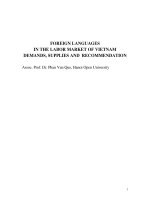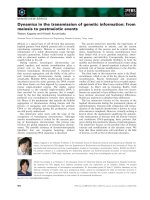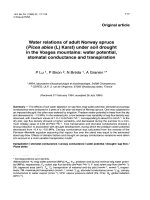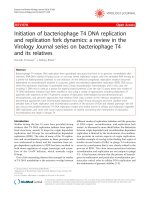Flow dynamics in the long xuyen quadrangle under the impacts o f full dyke systems and sea level rise
Bạn đang xem bản rút gọn của tài liệu. Xem và tải ngay bản đầy đủ của tài liệu tại đây (1.47 MB, 10 trang )
VNU Journal of Science, E arth Sciences 28 (2012) 205-214
Flow dynamics in the Long Xuyen Quadrangle under the
impacts o f full-dyke systems and sea level rise
Van Pham Dang Tri*, Nguyen Hieu Trung, Nguyen Thanh Tuu
C ollege o f E nvironm ent and N atu ral R esources -
cần Thơ
U niversity
Received 8 June 2012; received in revised form 22 June 2012
Abstract. A one-dimensional (ID ) hydrodynamic model for the river network o f the Long Xuyen
Quadrangle, Vieứiamese Mekong Delta, was developed in HEC-RAS based on; (i) Available data
o f river network and cross-sections deployed in the ISIS-ID hydrodynamics model for the whole
Mekong Delta (including the Vietnamese and Cambodia parts); and, (ii) Field-based data to update
ứie existing river network and iull-dyke systems. Developed scenarios included: (i) Scenario 1:
The measured geom eừic data in 2000 (no dykes constructed), and upsưeam discharge and sea
level measured m 2000; (ii) Scenario 2: The developed flill-dyke systems, and upstream discharge
and sea level measured in 2000; and, (iii) Scenario 3: The geometry and upsfream discharge
remained similar to Scenario 2 while the sea level was supposed to be 30 cm greater than that in
2000 (in both the East and West Sea). B y comparing Scenario 1 and 2, possible impacts o f the fulldyke systems to the area could be examined while by comparing Scenario 2 and 3, impacts o f sea
level rise would be evaluated in ứie context o f ứie deployed full-dyke systems.
Keywords: One dimensional (ID ) hydrodynamics model, flow dynamics, full-dyke systems, HECRAS, and Long Xuyen Quadrangle.
1. Introduction
a.msl). During the annual flood period (July November), the LXQ is often inundated with
flie greatest recorded stage of about 5,5 m a.msl [1].
The Long Xuyên Quadrangle (LXQ),
located in the An Giang, Kiên Giang and cần
Thơ provinces, the Vietnamese Mekong Delta
(VMD), is formed by the common border
between Việt Nam and Cambodia, the Bassac
River, the Cái sắn canal and the West Sea
(Figure 1). It is characterized by the low-lying
plain with the average elevation o f the land
surface of about 0,4 - 2,0 m above mean sea
level (a.msl) (except mountainous landscape
with the maximum height o f greater than 250 m
In the recent years, with great impacts o f
the on-going climate change in conjunction
with
rapid
development
o f hydraulic
consừTictions (e.g. concrete dyke systems or
full-dyke systems), flow nature o f tìie study
area has been sfrongly changed leading to
negative impacts on the agriculture and
aquaculture activities [2]. In fact, the ừends of
raising full-dyke to protect the rice field
enhancing the triple rice crop fanning system
per year have led to considerable negative
impacts o f the flow nature both in channels and
adjacent floodplains [3].
Coưesponding author. Tel: 84-909552092.
E-mail:
205
206
V.P.D. Tri et al. / V N U Journal o f Science, Earth Sciences 28 (2012) 205-214
Figure 1. Vietaamese Mekong Delta, Long Xuyen Quadrangle and developed river network.
With rapid development o f computer
science over the last decade, (numerical)
hydrodynamics models have been upgraded
significantly supporting flood propagation
simulation over a large river network, and
projecting future patterns according to changes
o f the boundary
conditions
(upstream
discharge, downstream water level, and m-situ
hydraulic
constructions).
Different
hydrodynamics models were developed (e.g.
VRSAP, MIKE, ISIS, Hydro-GIS, HEC-RAS)
to study the flow dynamics in different river
networks in the world. In Vietaam, examples of
the related works could be accounted for [2, 46]; however, most o f the previous works paid
great attention to flood extents over a large area
o f the deltaic scale or even with smaller scale
(regional scale) [7] but little attention was paid
to study the hydraulic nature (changes)
(including: simulated stage and discharge)
within the local river network at different
period of time. This paper aims at developing a
one-dimensional (ID ) hydrodynamics model
(HEC-RAS) to study the flow dynamics o f a
complex river network in the LXQ. Such
developed model, after calibrated, would be
applied to study the flow changes after different
pre-defined scenarios (Table 1).
2. Methodology
2.1. Governing equations
In this research, an unsteady-flow
hydrodynamics model was developed in HECRAS (a completed model software developed
by the Institute for Water Sciences, Hydrologic
Engineering Center and suitable to study the
hydraulic nature o f open channels [8]). The
HEC-RAS model is mainly governed by Equ. 1
and 2 [8]. In addition, the Manning’s n
hydraulic roughness coefficient (Equ. 3) was
used to calibrate the developed model.
Continuity equation
ÕA
—
dt
ÕS
+ —
ÕÍ
dQ
+ —
dx
-Ợ, =
0
( 1)
V.P.D. Tri ei a i / V N Ư Journal of Science, Earth Sciences 28 (2012) 205-214
Energy equation
õt
Õx
^õx
+ s.
=
0
(2)
Manning’s n hydraulic roughness equation
n
■'
(3)
where, A: Wetted area (m^); t: Time (s); S:
Storage in the wetted area (m^); Q: Discharge
(m^s'‘); x: Distance along the thaweg (m); qi'.
Lateral flows along a river section (between
tw o cro ss-sectio n s) (m^s '); V: M ean v elo city
(ms''); z: Water level (m); Sf. W ater surface
slo p e (m m '); n: H ydraulic rou gh n ess (sm '^^);
and, R: Hydraulic radius (m).
2.2. Available data
The river network o f the LXQ was
extracted from the ISIS-ID hydrodynamics
model provided by the Mekong River
Commission [2]. Details o f the developed HECRAS model for the LXQ include (Pigiưe 1.):
- 257 river reaches (including the Bassac
River) associated with 1,280 cross-sections, 145
nodes (junctions), and 130 storage areas;
- Boundary conditions (time step = 1 hour),
includmg: (i) Upsfream boundary conditions time series calculated discharge at the Châu
Đốc and Vàm Nao stage gauges; and, (ii)
Downsfream boundary conditions - time series
measured water level at 25 locations adjacent to
the West Sea and 1 locations in Long Xuyên.
The upsfream discharges were extracted from
the deltaic scale model (ISIS-ID) in
comparison witìi the interpolated discharge in
2000 at Châu Đốc. The overland flows were not
considered in this study due to the lack of
available information; however, the developed
model was calibrated to reflect the measured
stages at different locations in ửie area (Xuân
207
Tô and Tri Tôn from July to November, 2000).
In addition, each storage area was created
isolatedly from the others through a dense canal
network in the study area.
The secondary data o f the river banks and
river bed elevation in 2000 were collected to
validate and update available data in the ISISID hydrodynamics model. In addition, data
related to the existing dykes system in 2011
was also collected and deployed in the model;
the collected data includes: geographical
locations o f the existing dyke systems, area of
the protected areas, and dyke-height in the field.
In this study, only cross-sections developed in
the ISIS-ID hydrodynamics model was applied
with adjustoent according to the field data
observations and the full-dyke systems were
applied with ‘assumed’ dyke height which
would prevent flood to enter intensive ricecultivated areas. The assumption was made in
order to examine the hydraulic changes o f the
floods in the case that all actual rice farming
stystems in An Giang were fully protected.
The storage areas in HEC-RAS would be
introduced mto the developed model as dykeprotected areas. In the scenarios o f existing fulldyke system, the storage area would be kept dry
(no over-bank flows from river entering the
cultivated area) while in the scenario where
full-dyke systems was not developed, flows
from the river would be routed into the storage
area after reaching the elevation o f the bank
surface. In fact, when the water surface
elevation in the river channels was greater than
the dyke height, flows would be routed from
channels into the storage area (Qiaterai > 0). The
storage areas could be linked with one or more
river channels via the on-bank constructions.
Areas o f the storage area was measured in
ArcGIS in the available map o f existing dyke
system and then assigned in HEC-RAS. The
208
V.P.D. Tri et aỉ. Ị V N U journal of Science, Earth Sciences 28 (2012) 205-214
bed elevation o f the storage area was
established via the field survey and secondary
data. In this study, impacts o f rainfall were
neglected as it would result in minor impacts on
the hydraulic nature o f flows in the study river
network. In fact, inundation in the VMD is
mainly driven by upstream discharges, the
buffering flood wave in the Great Lake,
Cambodia and tidal regimes in the East and
West sea [9].
The developed hydrodynamics model was
calibrated by adjustmg the hydraulic roughness
coefficient (Manning’s n) o f each river channel
(i.e. changing the applied M anning’s n
coefficient o f a group o f cross-sections rather
than each individual cross-section [10]). The
calibrating process was done based on the
existing hydraulic roughness o f the crosssection m the available deltaic model and
adjusted gradually until the Nash-Sutcliffe
index value (R^) (Equ. 4) calculated according
to the measured and simulated stages met the
requirement. In fact, the calculated NashSutcliffe index should close to 1 [7,11].
The Nash-Sutcliffe index
2 j[ Ổ > íw ,ì
i=l
N
Q sim ,l
________ I
_
(4)
I Q o b s,i ~ Q o b s
i=l
w here; Qsim, Qobs- Simulated and measured
data; and, Qgfjy Mean measured data.
full-dyke systems with the spatial extents of the
year 2011 and sea water level was the measured
on in 2000 (Scenario 2); and, (iii) with similar
assumptions in Scenario 2 except the sea level,
which was assumed to be 30 cm greater than
that in 2000 (corresponding to the medium
emission scenario B2 [12]) (Scenario 3).
Table 1. Developed scenarios
U pstream
discharge
Scenarios
W ater
level (H)
Dyke
system
(Q)
Scenario
Q 2000
H2000
Q2OOO
H2000
Q2OOO
Sea level in
2000 + 30
cm
1
Scenario
2
Scenario
3
Actual
status in
2000
Full-dyke
system
Full-dyke
system
3. Results
3.1. Calibration
With tiie hydraulic roughness o f 0,029
(within the aưange o f accepted hydraulic
roughness for alluvial channels [0,010 - 0,035]
[13, 14]) applied for all cross-sections o f the
developed model, the simulated stages were
similar to the measured ones, especially during
the peaks o f flood (Figure 2); the calculated
Nash-Sutcliffe indexes were greater than 0,8
(Table 2).
Table 2. The calculated Nash-Sutcliffe indexes at
the selected locations (Xuân Tô and Tri Tôn)
2.3. Model set-up
Scenarios were developed (Table 1) in order
to evaluate the flood dynamics and extent on
the study area (i) when there was no full-dyke
system (Scenario 1); (ii) with tìie existence of
Station
Nash-Sutcliffe index
XnTƠ
0,88
Tri Tôn
0,81
V.P.D. Tri et aỉ. / V N U journal o f Science, Earth Sciences 28 (2012) 205-214
209
Figure 2. Measured and simulated stages at Xuân Tô (a) and Tri Tôn (b).
3.2. Simulated stages in different scenarios
ửi order to reflect the hydrodynamics in ửie
VMD after the defined scenarios, different
locations were selected (i.e. Location 1, 2, 3 and
4 in Figure 1 to fully represent the flow
dynamics at different parts o f the river
network). In general, there were significant
changes in simulated stages in different
locations according to Scenario 1 and 2 (Figure
3) (i.e. simulated stages in Scenario 2 was
greater than those in Scenario 1 in the rising
phase of the flood period while it was turned to
an opposite dynamics in the falling phase o f the
flood period). The findings prove that with the
development o f the full-dyke systems,
hydrodynamics o f the river network was
changed significantly. In fact, in the rising
phase, in the scenario with the existence o f the
full-dyke system, flood discharges were mainly
routed along the channels but not the
floodplain; therefore, the simulated stages rose
much higher than those in the case o f dyke-free
system. In the fallmg phase o f the flood period,
in the case where there was no dyke, discharges
were routed from the floodplain (which were
conveyed in during the early phase o f the flood
period) to the river; therefore, the stages in the
river were greater than those in the case with
the existence o f the full-dyke systems. In other
words, with the existence o f full-dyke systems,
the stages in the channel were only dependent
on the upstream flow while in the case o f a
dyke-free system, stages also depended on the
flow recharged from the floodplain to the river
network.
There were minor changes between
Scenario 2 and 3 (Figure 3). In fact, the selected
locations (Location 1, 2, 3 and 4) were rather
further away from the East Sea therefore sea
level rise did not give much influences on the
simulated stages; ữiis agrees with what was
found in [4]. At the Location 1, simulated
stages in Scenario 3 were lower than those in
both Scenario 1 and 2, which could be
explained as greater discharges were routed
along the Bassac River in both Scenario 2 and 3
than those in Scenario 1 (Figure 6) due to the
impacts o f the developed dyke system.
210
V.P.D. Tri et al. / V N U Journal of Science, Earth Sciences 28 (2012) 205-214
Location 2
6.0 -
I
1
1
1
i
s.o 4.0 3.0 2.0 l.o
“
S c e .l
0.0 -
/
/
/
/
/
-------S
/
/
/
/
------ Sce.l(M)
--------Sce.2{H)
/
/
/
-------Sce.2(H)
/
-------H (Sce3)
/
/
/
..-p '
------- &C«.2(H)
-------Sce .l{M )
/
/
------ H(Sce3)
/
/
/
■Sc«.l(H)
/
/
■Sce.2(H)
------ H (Sce3)
/
j-i-'
H (Sceỉ)
Figure 3. Simulated stages at different locations (Figure 1) according to ứie three scenarios.
3.3. Impacts o f upstream flow s
downstream stages
on
the
With greater flows entering the Vĩnh Te
canal in Scenario 2 and 3 in comparison to
those in Scenario 1 (Figure 1, denoted as U),
the simulated stages at the upsừeam section of
the Vĩnh Te canal in Scenario 2 and 3 were
greater than those in Scenario 1 in the rising
phase o f ửie flood period while they were all
similar in the falling phase (Ư and M l in Pigiưe
4).
According to the M anning’s n equation
(Equ. 3), during the falling phase of the flood
period, when the discharge increased with
relatively similar stages, the water surface slope
would increase. This led to the decrease of
stages in the lower parts o f the Vĩnh Te canal
(M2 and D in Figure 4). Nearby the
downsfream boundary conditions (the West
Sea), simulated stages in Scenario 1 and 2 were
similar while the simulated stages in Scenario 3
were significantly different from those in
Scenario 1 and 2, which were caused by the
defined scenario o f sea level rise. The findings
confirm that ửie upsừeam part o f the study area
would be sừongly influenced by the upsfream
discharge changes as well as hydraulic
construction development in the upsữeam
section while the downstream section was
sừongly affected by the sea level rise [4], In
addition, changes o f water surface slope might
lead to changes o f flow velocity, which in turn
would lead to changes o f the morphology o f the
river / channel network [15-17],
211
V.P.D. Tri et aỉ. ỉ V N U Journal of Science, Earth Sciences 28 (2012) 205-214
Ml
6.0 Ị
5.0 -Ị
4.0 -Ị
3.0 i
2.0
1.0 -j
0.0
/ / / /
--------S c e .l(M 3
^
/ / / / / /
/ / / /
---------S c « .2 (H Ị
------ Sce .llH )
--------H { S c c 3 )
------- Sce.2(H)
------- H (S c e 3 )
|g j^ |6a
/
/
/
•Sce.l(H)
/
/
•Sce.2 (HỊ
/
/
vA
1
1
!
1
1
1
1
1
Í
^
uA ^ ^ .J0s>.vS.kN
1
H{5ce 5)
Figure 4. Simulated stages (from upsfream to downstteam) at different locations along the Vinh Te canal
according to the three scenarios.
Due to the complexity o f ửie river platform,
the
flow dynamics were also highly
convoluted. Considering location FD in Figure
1,
simulated discharges
were
sfrongly
influenced by the development o f the full-dyke
system. In fact, without the existence o f the
full-dyke system in the upstream part o f the
study area (Scenario 1), flows were sfrongly
routed from the upstream to the sea; however,
with the impacts o f the developed dyke systems
(Scenario 2 and 3), less flows were routed along
the secondary channel from inland to ửie sea (in
comparison to Scenario 1) (Figure 5) but rather
to be routed along the Bassac.
Figure 5. Flows changed according to changes o f boundary conditions in different scenarios.
212
V.P.D. Tri et al. / V N U Journal o f Science, Earth Sciences 28 (2012) 205-214
3.5. Possible impacts o f full-dyke system and
sea level rise on the flo w dynamics in the main
river channels
Time-series data o f simulated stages and
discharges along the Bassac River were closely
inteưelated, in which stage rose / fell with
discharge during the flood period. The
simulated flows and stages in Scenario 1 were
lower than those in Scenario 2 and 3. In fact,
with impact o f the full-dyke systems, flows
were mainly routed along the main channel but
not into the floodplain; therefore, the flows
routed along the Bassac increased in both
Scenario 2 and 3 (Figure 6). The findings raised
a concern that rising dyke to protect the
upstream areas against flood may cause greater
damages in the downstream sections (including
flood depth and duration period) [18, 19]. In
comparison between Scenario 2 and 3 (i.e. with
and without sea level rise), even though the
simulated discharges between the two scenanos
were relatively similar, the simulated stages in
the condition o f sea level rise would be slightly
smaller in the rising phase during the flood
period while it would be greater in the falling
phase. Such relationship between the flows and
stages proves that flows in the Bassac would be
more strongly affected by the tidal regimes
(rather than upsfream discharge driven only),
leading to an actual requirement for a detailed
study to evaluate impacts of sea level rise on
the hydraulic nature of the Bassac River.
Failing phase
3.3
1
2.8
&
Rising phase
1.3
,000
7,500
9,000
10,500
12.000
13,500
15.000
16,500
simulated discharee (m’r'J
-Scenario 1 X Scenario2
Scenario 3
Figure 6. Flow and stage dynamics in the Bassac River (denoted as A, Figure 1.).
4. Conclusions
A ID hydrodynamics model developed in
HEC-RAS could be used to study the flow
dynamics o f the river network in the LXQ
according to different scenarios o f boundary
condition changes (sea level rise and full-dyke
system development). With such the developed
hydrodynamics model, details o f hydraulic
nature were studied in more details (in
comparison to the deltaic-scale hydrodynamics
model [2, 5, 6]) especially in the context of
boundary condition changes.
With impacts o f the developed full-dyke
systems, water levels in the main channels were
greater than those in the case o f the dyke-free
system. The simulated water surface slope in
Scenario 2 (existence o f full-dyke and measured
V.P.D. Tri et aỉ. / V N U Journal of Science, Earth Sciences 28 (2012) 205-214
sea level in 2000) was greater than that in
Scenario 1 (dyke-free), which may cause great
changes o f the morphology o f the river
network. Such morphological changes are of
great concerns as they may lead to unexpected
deposition or erosion along the river network
which then might lead to negative impacts on
livelihood o f local residents [18-21]. In
addition, when full-dyke system was built,
flows were mainly transported along the main
channel (the Bassac), leading to rises o f water
level in the upstream areas (along the Bassac)
and caused negative impacts on the agriculture
and aquaculture activities in the North-West
area o f An Giang. Moreover, the projected sea
level rise led to major hydrological changes in
213
A cknowledgem ent
Authors o f tìie paper are very grateful for the
great comments o f the reviewer (Assoc. Prof.
Dr. Trần Ngọc Anh) to improve the paper.
References
[1]
MRCS. Hydrological and Flood Hazards in the
Lower Mekong Basin, The Flood Management
and Mitigation Programme, Component 2:
Structural Measures & Flood Proofing in the
Lower Mekong Basin.
Mekong
River
Commission Secretariat, 2009.
[2]
Van PDT, Popescu I, van-Griensven A,
Solomatine D, Trung NH, Green A. A study of
the climate change impacts on fluvial flood
propagation in the Vietnamese Mekong Delta.
Hydrol. Earth Syst Set Discuss. 9 (2012) 7227 70.
[3]
Smith JK, Chacón-Moreno EJ, Jongman RHG,
Wenting PH, Loedeman JH. Effect of dyke
construction on water dynamics in theflooding
savannahs of Venezuela. Earth Surface
Processes and Landforms, British Society fo r
Geomorphology. 31 (2006) 81.
[4]
Wassmann R, Hien NX, Hoanh CT, Tuong TP.
Sea level rise affecting the Vietnamese Mekong
Delta: water elevation in the flood season and
implications for rice production. Climatic
Change. 66 (2004) 89.
[5]
The hydraulic roughness o f a river channel
might vary according to the river depth and
water surface slope [14, 22]. Therefore, the
assumption o f having one value o f hydraulic
roughness for a large series of river stages
might not be appropriate and it is suggested to
improve the developed hydrodynamics model
Le TVH, Nguyen HN, Wolanski E, Tran TC,
Haruyama s. The combined impact on the
flooding in Vietnam's Mekong River delta o f
local man-made structures, sea level rise, and
dams upsừeam in the river catchment.
Estuarine, Coastal and Shelf Science. 71 (2007)
[6]
Dung NV, Merz B, Bárdossy A, Thang TD,
Apel H. Multi-objective automatic calibration
o f hydrodynamic models utilizing inundation
maps and gauge data. Hydrol Earth Syst Sci.
15(4) (2011) 1339-54.
for the future studies.
[7]
Dinh Q, Balica
Climate change
vulnerability and
Quadrangle in the
Journal o f River
(2012) 103-20.
the coastal plains in comparison to the
consequent impacts in the upsừeam sections of
the VMD, which fully agrees with the findings
from previous study [2,4].
In this study, the developed hydrodynamics
model was not validated (due to limited
available data); it is suggested that related data
should be continuously collected to make sure
the model is well-calibrated and validated. In
addition, in this study, attention was great paid
to study the flow and stage changes but the
consequent impacts on morphology were not
well explored.
s,
Popescu I, Jonoski A.
impact on flood hazard,
risk of the Long Xuyen
Mekong Delta. International
Basin Management. 10(1)
214
V.P.D. Tri et a i Ị V N U Ịournaỉ of Science, Earth Sciences 28 (2012) 205-214
[8]
Brunner GW. HEC-RAS: River analysis system
user’s mannual (version 4.1). u s Army Corps of
Engineers, Institute for Water Sciences,
Hydrologic Engineering Center (HEC) 2010.
[16] Ramos J, Gracia J. Spatial-temporal fluvial
morphology analysis in the Quelite river: It’s
impact on communication systems. Journal o f
Hydrology. 412-413 (2012) 269-78.
[9]
Hung NN, Delgado JM, Tri VK, Hung LM,
Merz B, Bárdossy A, et al. Floodplain
hydrology of the Mekong Delta, Vietnam.
Hydrological Processes. 26(5)(2012) 674-86.
[17] Amsler ML, Ramonell CG, Toniolo HA.
MoqDhologic changes in the Parana River
channel (Argentina) in the light of the climate
variability
during
the
20th
century.
Geomorphology. 2005;70(3-4):257-78.
[10] Pappenberger F, Beven K, Horritt M, Blazkova
S. Uncertainty in the calibration of effective
roughness parameters in HEC-RAS using
inundation and downsừeam level observations.
Journal o f Hydrology. 302(1-4) (2005) 46-69.
[18] Haque CE. Impacts of river bank erosion on
population
displacement
in
the
lower
Brahmaputra (Jamuna) floodplain. Popul Geogr
1986;8(1 -2):1 - 16.
[11] Đức ĐĐ, Anh TN, Như NÝ, Sơn NT. ứng dụng
mơ Hình MIKE FLOOD tính tốn ngập lụt hệ
thống sơng Nhuệ - Đáy ừên địa bàn thành phó
Hà Nội. Tạp chỉ Khoa học Đại học Quốc gia
HàNọi. 27 (2011)37-43.
[19] Lazarus K, Dubeau p, Bambaradeniya c , Friend
R, Sylavong L. An Uncertain Future:
Biodiversity and Livelihoods along the Mekong
River in Northern Lao PDR. IƯCN: Bangkok,
Thailand and Gland, Switzerland, 2006.
[12] MONRE. Climte change, sea level rise
scenarios for Vietnam. Ha Noi: Institute of
Meteorology, Hydrology and Environment,
2009.
[20] Rahman MA, Rahman MM. Impact o f
livelihood practices on the char dwellers
economic condition in riverine chars; Case
studies in Bangladesh. Journal o f the
Bangladesh Association of Young Researchers.
2011; 1( 2).
[13] Chow VT. Handbook o f applied hydrology:
McGraw-Hill Book Co., Inc.; 1964.
[14] Jarrett R. Hydraulics o f High - Gradient
Streams. J//>JraM /£ng. 110(11) (1984) 1 5 1 9 39.
[15] Rodrigues s, Bréhéret J-G, Macaire J-J, Moatar
F, Nistoran D, Juge p. Flow and sediment
dynamics in the vegetated secondary channels
o f an anabranching river: l l ie Loire River
(France). Sedimentary Geology. 186(1-2);
(2006) 89-109.
[21] Ahmed AA, Fawzi A. Meandering and bank
erosion o f the River Nile and its environmental
impact on the area between Sohag and ElMinia, Egypt. Arabian Journal o f Geosciences.
4(1-2) (2009) 1-11.
[22] Van TPD, Carling PA, Atkinson PM. Modelling
the bulk flow o f a bedrock-consừained, multi
channel reach o f the Mekong River,
Siphandone, southem Laos. Earth Surface
Processes and Landforms. 37(5) (2012) 533-45.









